One hundred years ago the Arras offensive in northern France started. The opening attacks included the Battle of the Scarpe in which the Cavalry Corps played a major part. Actually this was the main battle honours for the cavalry in the war.
This is the story of Jack Greenwood, my Grandfather, who was probably at the battle. His regiment, the 3rd Dragoon Guards, were key in capturing Monchy-Le-Preux, a village on the main objective line for the attack. I can’t say he was definitely there, he may have been injured, ill or perhaps detached to another unit. A separate blog will cover more of the scope of the battle and the role the 3rd Cavalry Division. But this is Jacks story, on the assumption he was with main regiment on those days of April 1917.
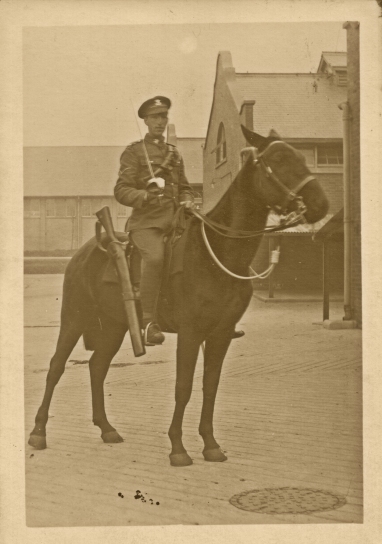
Jack had joined the Cavalry in York, probably in 1916, before transferring to the 3rd Dragoon Guards. After writing a love letter to his girl friend, my grandmother. He set out from the Canterbury training base on Wednesday 14th February 1917 heading to Rouen before arriving at their winter quarters at Aix-en-Issan close to the French coast at La Toquet.
Compared to the infantry on the front line, the Cavalry had a relatively easy life in France. In the winter of 1917 they spent their days training and parading. They learnt about communications using pigeons and signalling. After nearly 3 years of war, tactics had changed and the mounted forces were viewed as one of several mobile elements. Usually held in reserve, the cavalry waited for the right battle, terrain, weather and opportunity to engage the enemy. Other mobile forces now were Tanks, armoured cars, aeroplanes and bicycle mounted troops – all working with the infantry to support any breakthrough of the enemy lines. Horsemen were expected to use their mobility if breakthroughs were not possible. They were to get to places quickly, dismount and provide sophisticated fire with their light Hodgkiss machine guns. A headlong charge was by now a tactic of previous wars, although in this coming battle that is what they actually did.
Working out who was where during this battle requires an understanding of the organisation of the Cavalry. The 3rd Dragoon Guards Regiment were made up of 3 squadrons (A,B and C). The Guards were part of the 6th Cavalry Brigade along with 2 other regiments, the 1st Dragoons (which Jack Greenwood was in when he initially joined up) and the 19th Hussars. Together with the 7th Brigades they formed the 3rd Cavalry Division. The 3 Cavalry divisions formed the Cavalry Corp. Hope that makes it clear!
At the beginning of April 1917, in the build up to the Arras offensive, the 3rd Dragoon Guards marched 50 miles to Gouyen en Artois, around 5 miles to the west of Arras. Here the Cavalry Corp gathered, ready to be called forward as the offensive progressed. According to the regimental diary, they were in the best of spirits and full of enthusiasm. At that time there were 25 Officers and 515 other ranks in the 3rd DG Regiment.

On the morning of the 9th April the Battle of Arras started. Compared to the way trench warfare had usually gone in the previous years of the war, this was a success. During that day three and a half miles of depth was taken by the infantry, although they did fall short of their objective, held up short of the town of Monchy-le-Preux.
While the infantry were advancing, the 3rd Cavalry Division, (including the 3rd Dragoon Guards, see above), moved closer to Arras for their approach march. Part of the division, the 6th Cavalry Brigade, went into a bivouac while the officers surveyed the German trenches captured that day and planned the following days moves. During the night the weather turned from being fine to bitterly cold and snowy.
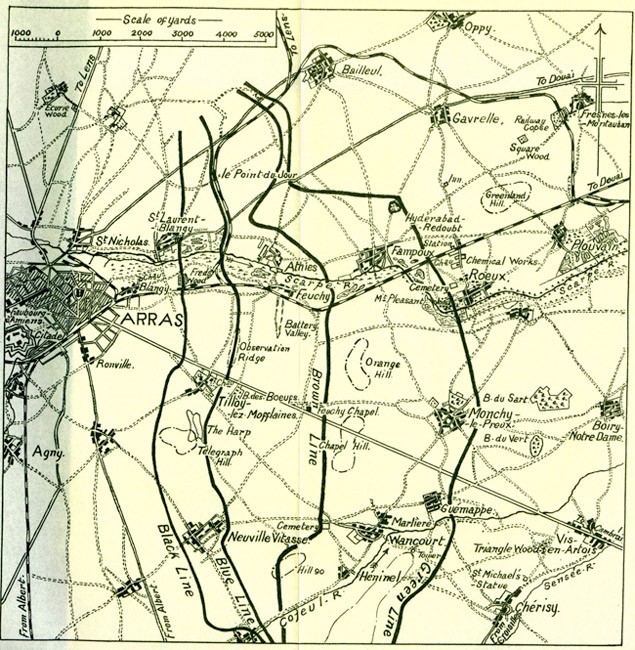
Original 1917 Map of Arras Battle Zone (WFA / IWM)
Next day, Tuesday the 10th April, the 3rd DG were sent to construct crossings over the captured trench lines. Whilst this heavy work was underway, patrols went forward to find out the situation at the front line and to report on the progress of the infantry at Monchy-le-Preux. Once out in the open, the patrols came under enemy shelling, causing a few casualties in men and horses. A fresh attack on Monchy was planned for the next day, so the Dragoons moved back to a safer position to bivouac again for another wet and cold night. No hot food was available and the ground was too soft to put up picket fences, so the men sheltered in shell holes holding onto the horses as in the official photo below.

At 5:30am on the morning of the April 11, four regiments from 3rd Cavalry Division set off to support the infantry attack. This included the 3rd Dragoon Guards who were at the head of the 6th Brigade as they moved into position behind the captured trenches. The infantry had moved ahead so mounted patrols were sent out to keep in touch. By 8:30am it was reported that Monchy had been taken but still subject to counter-attack. Actually, the reports were wrong, fighting was still in progress and it was not going well in the town. So the Cavalry were called for and they started their advance across the trenches they had filled-in the previous day. Records of the battle and the regimental war diary explain they were to contour just north of the Cambrai Road, 1,000 yards E of Feuchy Chapel. These can be seen in the battle maps I have included below. B Squadron from the Dragoon Guards advanced in line of troop columns and started to galloped steadily across the ground.
An advance in brigade strength like this was a rare enough sight to make a significant impression on the watching infantry. Captain Cuddeford of the Highland Light Infantry (part of 15th (Scottish) Division) was a witness to this advance:
“During a lull in the snowstorm an excited shout was raised that our cavalry were
coming up! Sure enough, away behind us, moving quickly in extended order
down the slope of Orange Hill was line upon line of mounted men covering the
whole extent of the hillside as far as we could see. It was a thrilling moment for
us infantrymen, who had never dreamt that we should see a real cavalry charge,
which was evidently what was intended.”
Another witness said;
“Just after dawn, we got the surprise of our lives when from a copse on our right there emerged the cavalry. It was a thrilling sight to see them line up in one long line. Then, with the officer and standard-bearer in the centre they set up a yell and set off hell for leather towards Monchy-Le-Preux. We all stood up in the trench and yelled with them. The element of surprise was on their side because they got half way to Monchy before the Germans realised what was happening – then all hell was let loose and Jerry threw everything he had got at them.”
According to the war diary, heavy shelling was experienced immediately after leaving and 3 German machine guns continually swept the valley causing many casualties amongst the horses. By 9:00am they reached the outskirts of the Monchy village where they dismounted and took up a fire position with their Hotchkiss Machine Guns. There they came under a hostile artillery barrage and very heavy machine gun fire which caused them to suffer a good many casualties.
The Germans then counter-attacked, advancing in strength from the NE but the dismounted brigade of the 3rd DG and Essex Yeomanry stopped the enemy. The rest of the Brigade arrived and they joined with the advance infantry, about 50 men of the N. Lancs. They all dug into abandoned trenches and returned fire.
Whilst the officers went to study the situation those in the trenches made contact with the command posts at rear of the lines. Signalling, (probably flags but may have been carrier pigeon as they had been training with these recently), was resumed as the Royal Horse Artillery (RHA) arrived and began to return heavy fire on the enemy.
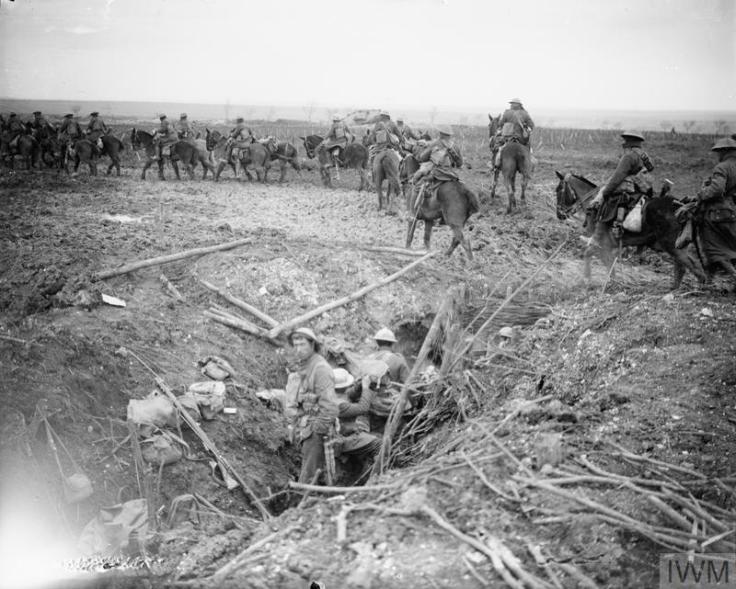
It was now 9:30am and a troop of the guards galloped forward towards Les Fosses farm supporting small groups of infantry that were there, about 20 men from the 112th brigade. More RHA arrived and shelling continued for the next 2 hours or so until 12:00 when the guns and horses were sent back to the reserve position. This movement caused a good deal of shelling and they took casualties as they went back. Five minutes after the horses of the 3rd DG had left, five German aircraft were over the position and the whole valley was subject to heavy shelling. Further up on the left of the Scarpe valley the 8th Brigade suffered heavily from the shelling.
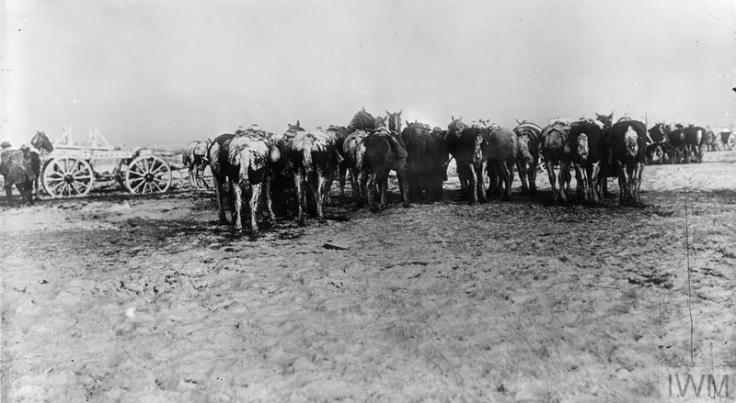
By 2pm, the Germans started amassing for a counter attack from St Roharts Factory on the outskirts of the village. As the troop had been weakened by the action so far and many men had gone back with the horses, reinforcements in the shape of the heavy Machine Guns of the M.G. Squadron along with the dismounted North Somerset Yeomanry were sent from the reserves to reinforce the line. They had to march to the front line with horses only carrying equipment.
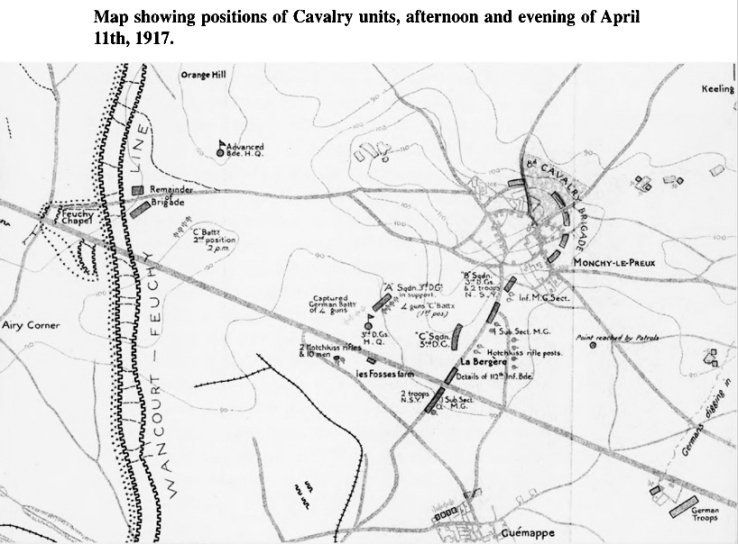
After an hour those left on the front line watched an attack by the Gordon Highlanders from the SW of the farm. which was brought to a standstill by an intense German Artillery barrage. Half an hour later, the dismounted reinforcements arrived somewhat fatigued, after a long march with all their equipment and ammunition.
All the troops then moved forward along with the Machine Gunners to move forward. Just south of the road 25 infantry had gathered in a trench, organised into a defence post by Private Batchelor of the 6th Bedfords. He had collected German rifles, ammunition and bombs for his party as they had only 5 rounds of their own ammunition left.
As they approached the outskirts of the village they came across an advance British MG post and more abandoned German guns and ammunition. The Dragoons had fought all day so around 5pm the Guards were told they would be relieved that evening. ANother regiment of infantry, the 13th Kings Rifles, came through and built strong points in front of the Dragoons.
After the position was safely strengthened they had a visit from the Officer Commanding 3rd D. Gds, who found “all correct and in excellent order. The men had worked splendidly and the Germans had ceased to worry (them) for the time being“. He later reported very favourably on the small machine guns they were using – “the line held by 3rd D. Gds was defended entirely with Hotchkiss rifles which were able to break up an assembly of the Germans prior to their counter-attack.”
They arranged to hand over the trenches and evacuate the wounded before moving back to a collecting station which had been set up at Les Fosses Farm. Later that night, at 11:30pm they returned Arras and bivouac at the race course.
The casualties of the regiment were 1 Officer and 19 Other Ranks killed; 3 Officers and 56 Other Ranks wounded of which 3 died later; 196 horses killed or wounded. I could speculate that Jack Greenwood was amongst the wounded although I havent been able to find out when and where this picture was taken.
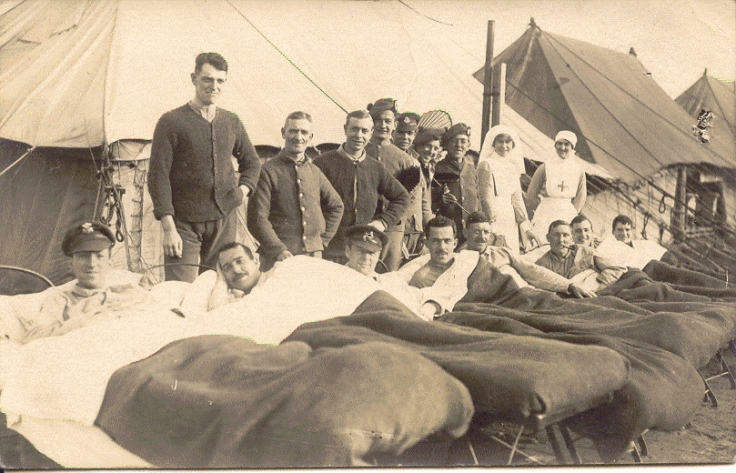
It would be difficult to conceive of worse weather for these important operations. Numbers of men in the Brigade, after having been out in the open for three nights in the snow, had to be evacuated suffering from exposure. The horses suffered even more than the men. Every night they stood out in the driving snow up to their hocks in mud and slush. On one occasion it was impossible to water them for close on 48 hours. It was recorded that it was extraordinary how quickly the horses picked up after a week’s rest and care.
That’s it for the First Battle of the Scarpe, in the Arras campaign. From what I can see from the Regimental War Diaries, the 3rd D Gds cavalry were only subsequently in skirmishes in support of Infantry battles. A full reading of the diaries awaits the winter.
Some of the language in this story may appear a little odd. Much of the events of the battle are copied from official documents and so are written straight after the event on the battlefield. I have also tried to remove most of the army jargon, which is difficult to follow without a full glossary. Grammar mistakes must be mine and the officers in 1917 would have had a better education in English at their grammar school than I had at my Secondary Modern.
1 Pingback